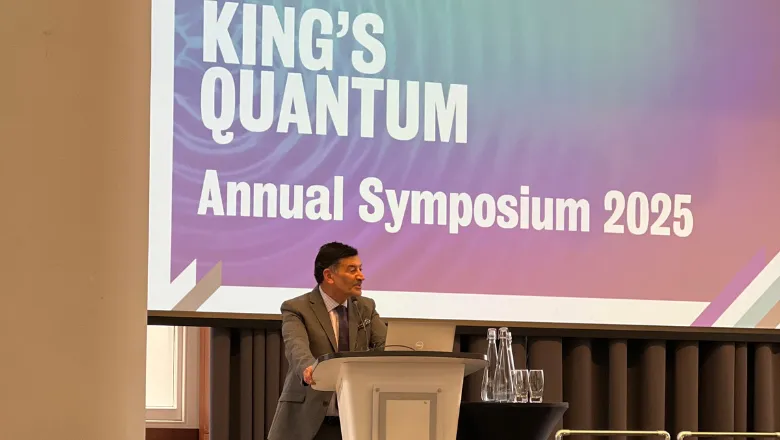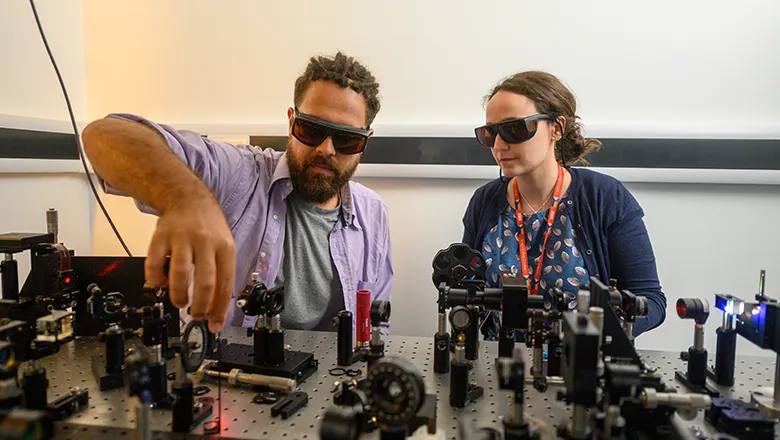
Professor Joe Bhaseen
Professor of Theoretical Physics
- Head of Theory & Simulation of Condensed Matter Group
Research interests
- Physics
Biography
Dr Joe Bhaseen is a Professor of Theoretical Physics in the Department of Physics, King's College London. His research in theoretical condensed matter physics falls in the area broadly known as strongly correlated systems. The overarching goal is to understand the wealth of phenomena exhibited by strongly interacting quantum matter. A common thread in his research is the application and development of quantum field theory approaches to these many body problems.
Research
My research in theoretical condensed matter physics falls in the area broadly known as strongly correlated systems. The overarching goal is to understand the wealth of phenomena exhibited by strongly interacting quantum matter. A common thread in my research is the application and development of quantum field theory approaches to these many body problems.
We investigate the phase diagram of bosons interacting via Feshbach-resonant pairing interactions in a one-dimensional lattice. Using large scale density matrix renormalization group (DMRG) and field theory techniques we explore the atomic and molecular correlations in this low-dimensional setting. We provide compelling evidence for an Ising deconfinement transition occurring between distinct superfluids and extract the Ising order parameter and correlation length of this unusual superfluid transition. This is supported by results for the entanglement entropy which reveal both the location of the transition and critical Ising degrees of freedom on the phase boundary.
Phys. Rev. Lett. 105, 043001 (2010)
Recent experiments on Bose--Einstein condensates in optical cavities have reported a quantum phase transition to a coherent state of the matter-light system -- superradiance. The time dependent nature of these experiments demands consideration of collective dynamics. Here we establish a rich phase diagram, accessible by quench experiments, with distinct regimes of dynamics separated by non-equilibrium phase transitions. We include the key effects of cavity leakage and the back-reaction of the cavity field on the condensate. Proximity to some of these phase boundaries results in critical slowing down of the decay of many-body oscillations. Notably, this slow decay can be assisted by large cavity losses. Predictions include the frequency of collective oscillations, a variety of multi-phase co-existence regions, and persistent optomechanical oscillations described by a damped driven pendulum. These findings open new directions to study collective dynamics and non-equilibrium phase transitions in matter-light systems.
Phys. Rev. Lett. 103, 265302 (2009)
Motivated by experiments on heteronuclear Feshbach resonances in Bose mixtures, we investigate s-wave pairing of two species of bosons in an optical lattice. The zero temperature phase diagram supports a rich array of superfluid and Mott phases and a network of quantum critical points. This topology reveals an underlying structure that is succinctly captured by a two-component Landau theory. Within the second Mott lobe we establish a quantum phase transition described by the paradigmatic longitudinal and transverse field Ising model. This is confirmed by exact diagonalization of the 1D bosonic Hamiltonian. We also find this transition in the homonuclear case.
Phys. Rev. Lett. 102, 135301 (2009)
Motivated by recent experiments on cold atomic gases in ultra high finesse optical cavities, we consider the problem of a two-band Bose--Hubbard model coupled to quantum light. Photoexcitation promotes carriers between the bands and we study the non-trivial interplay between Mott insulating behavior and superfluidity. The model displays a global U(1) X U(1) symmetry which supports the coexistence of Mott insulating and superfluid phases, and yields a rich phase diagram with multicritical points. This symmetry property is shared by several other problems of current experimental interest, including two-component Bose gases in optical lattices, and the bosonic BEC-BCS crossover problem for atom-molecule mixtures induced by a Feshbach resonance. We corroborate our findings by numerical simulations.
Phys. Rev. Lett. 98, 166801 (2007)
Since the discovery of high temperature superconductivity, quantum phase transitions between Mott insulators and superfluids/superconductors have been the focus of intense scrutiny. More recently, such transitions have been observed in ground breaking experiments on cold atomic gases. In collaboration with Prof. S. Sondhi and Dr A. Green, we have examined the magnetothermoelectric response at superfluid--Mott insulator transitions in the ubiquitous Bose--Hubbard model. This work is motivated, in part, by Prof. P. Ong's measurements in the cuprates. We use an approach based on the quantum Boltzmann equation to investigate the response in the quantum critical regime.
Quite aside from their relevance to high temperature superconductivity, Mott insulators are interesting because they lie outside the conventional band theory of metals, insulators and semiconductors; according to band theory Mott insulators ought to be metals. These materials are rendered insulators by the Coulomb interaction between electrons, and are a paradigmatic example of the impact of strong correlations. Quasi 1D Mott insulators, such as SrCuO2 and the Bechgaard salts, are especially interesting because their collective excitations are quite different from the electrons themselves. These novel "fractional'' excitations are termed spinons and holons and their existence has been confirmed by neutron and x-ray scattering experiments. In collaboration with Prof. F. Essler and A. Grage we have studied the magnetic correlations of 1D Mott insulators using field theory techniques.
An exciting feature of quantum many body systems is that the emergent behaviour of the aggregate may be significantly richer than that of its constituent particles. As in the 1D Mott insulator discussed above, the collective many body excitations may have "fractional'' quantum numbers, which differ from those of the electron or conventional spin waves. In collaboration with Prof. A. Tsvelik , we have investigated a family of spin ladder models where magnetic frustration leads to fractionalization.
The modern theory of phase transitions is highly developed, and an array of powerful theoretical tools are commonly employed. New problems arise in systems with disorder, such as those which exhibit the quantum Hall effect. A significant component of my doctoral research was directed towards the theory of second order phase transitions in low dimensional disordered systems.
Research

Theory & Simulation of Condensed Matter
Research is focused on the theory of condensed matter, and in particular the development and application of advanced theoretical and modelling techniques suitable for the study of complex materials and molecular systems and processes.

Centre for Non-Equilibrium Science (CNES)
CNES acts as an international hub for cross-disciplinary research in non-equilibrium science.

P23: Non-Perturbative Approaches to Non-Equilibrium Quantum Systems
Non-Perturbative Approaches to Non-Equilibrium Quantum Systems
Project status: Completed

P90: Effects of Dissipation on Non-Equilibrium Quantum Matter
Effects of Dissipation on Non-Equilibrium Quantum Matter
Project status: Completed
News
Great minds gather for King's Quantum Annual Symposium
Top scientific policy leads and industry voices joined a choir of King’s quantum researchers to discuss how to turbocharge the technology.

King's physicists in £7.7 million grant to develop metamaterials that change their properties in time
Varying the properties of materials at rapid speeds brings the potential to transform fields such as telecommunications, information processing, imaging and...

Dr Nicola Bonini
Remembering Dr Nicola Bonini

Research

Theory & Simulation of Condensed Matter
Research is focused on the theory of condensed matter, and in particular the development and application of advanced theoretical and modelling techniques suitable for the study of complex materials and molecular systems and processes.

Centre for Non-Equilibrium Science (CNES)
CNES acts as an international hub for cross-disciplinary research in non-equilibrium science.

P23: Non-Perturbative Approaches to Non-Equilibrium Quantum Systems
Non-Perturbative Approaches to Non-Equilibrium Quantum Systems
Project status: Completed

P90: Effects of Dissipation on Non-Equilibrium Quantum Matter
Effects of Dissipation on Non-Equilibrium Quantum Matter
Project status: Completed
News
Great minds gather for King's Quantum Annual Symposium
Top scientific policy leads and industry voices joined a choir of King’s quantum researchers to discuss how to turbocharge the technology.

King's physicists in £7.7 million grant to develop metamaterials that change their properties in time
Varying the properties of materials at rapid speeds brings the potential to transform fields such as telecommunications, information processing, imaging and...

Dr Nicola Bonini
Remembering Dr Nicola Bonini

